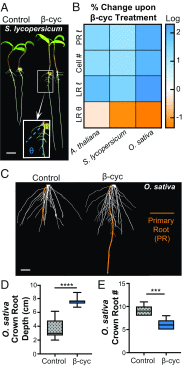β-Cyclocitral is a conserved root growth regulator
- PMID: 31068462
- PMCID: PMC6534974
- DOI: 10.1073/pnas.1821445116
β-Cyclocitral is a conserved root growth regulator
Abstract
Natural compounds capable of increasing root depth and branching are desirable tools for enhancing stress tolerance in crops. We devised a sensitized screen to identify natural metabolites capable of regulating root traits in Arabidopsis β-Cyclocitral, an endogenous root compound, was found to promote cell divisions in root meristems and stimulate lateral root branching. β-Cyclocitral rescued meristematic cell divisions in ccd1ccd4 biosynthesis mutants, and β-cyclocitral-driven root growth was found to be independent of auxin, brassinosteroid, and reactive oxygen species signaling pathways. β-Cyclocitral had a conserved effect on root growth in tomato and rice and generated significantly more compact crown root systems in rice. Moreover, β-cyclocitral treatment enhanced plant vigor in rice plants exposed to salt-contaminated soil. These results indicate that β-cyclocitral is a broadly effective root growth promoter in both monocots and eudicots and could be a valuable tool to enhance crop vigor under environmental stress.
Keywords: abiotic stress; carotenoid; lateral root emergence; meristem; plant hormone.
Conflict of interest statement
Conflict of interest statement: A.J.D. and P.N.B. have filed a patent application on the use of β-cyclocitral in enhancing root growth.
Figures




References
-
- Jain JL. (2005) Plant Hormones. Fundamentals of Biochemistry (S. Chand & Company, New Delhi: ).
Publication types
MeSH terms
Substances
Grants and funding
LinkOut - more resources
Full Text Sources
Other Literature Sources

